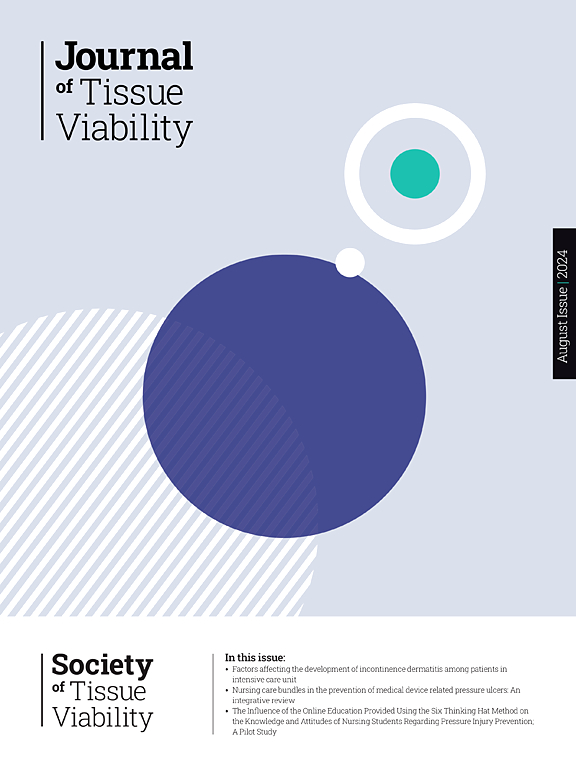Factors influencing wound complication risk in maxillofacial injury patients: Insights from a cross-sectional debridement and suturing study
IF 2.4
3区 医学
Q2 DERMATOLOGY
引用次数: 0
Abstract
Aim
This study focuses on wound complications after debridement and suture of maxillofacial injuries, aiming to accurately identify the risk factors and construct an effective prediction model.
Methods
A cross-sectional study was conducted in the emergency department of a tertiary dental hospital in southwest China from January to May 2024. Clinical data were obtained from patients who underwent debridement and suturing procedures for maxillofacial injuries under local anesthesia. Lasso regression was employed to identify risk factors, and binary logistic regression was utilized to construct the prediction model. The performance of the model was assessed based on accuracy, sensitivity, specificity, the receiver operating characteristic (ROC) curve, and the area under the curve (AUC).
Results
The incidence of postoperative wound complications was 25 % (196/783). Following Lasso regression analysis, 14 risk factors were identified. Subsequent binary logistic regression analysis, which included variables selected by the Lasso regression, revealed that wound complications were influenced by interval time between injury and visit (hours), endocrine disorder, accompanying caregiver, penetrating injury, tissue defect, duration of surgery (hours), anesthesia, and intraoperative cooperation of patients (p < 0.05). The calibration curve of the predictive model demonstrated high consistency between predicted and actual probabilities, with an AUC of 0.73.(95 % CI: 0.682–0.763).
Conclusions
This study developed a predictive model for postoperative complications in maxillofacial trauma by incorporating key risk factors including injury-to-visit interval, endocrine disorder, penetrating injury status, and tissue defects. The model enables precise perioperative risk stratification and personalized clinical decision-making, providing essential evidence-based guidance for trauma management.
影响颌面部损伤患者伤口并发症风险的因素:来自横断面清创缝合研究的见解
目的研究颌面部外伤清创缝合后的创面并发症,准确识别危险因素,建立有效的预测模型。方法于2024年1 - 5月在西南地区某三级牙科医院急诊科进行横断面研究。临床资料来自于在局部麻醉下对颌面部损伤进行清创缝合手术的患者。采用Lasso回归识别危险因素,采用二元logistic回归构建预测模型。根据准确度、灵敏度、特异性、受试者工作特征(ROC)曲线和曲线下面积(AUC)对模型的性能进行评估。结果术后创面并发症发生率为25%(196/783)。通过Lasso回归分析,确定了14个危险因素。随后的二元logistic回归分析,包括Lasso回归选择的变量,发现伤口并发症受伤至就诊间隔时间(小时)、内分泌紊乱、陪同护理人员、穿透伤、组织缺损、手术时间(小时)、麻醉和患者术中配合的影响(p < 0.05)。预测模型标定曲线的预测概率与实际概率具有较高的一致性,AUC为0.73。(95% ci: 0.682-0.763)。结论结合损伤至就诊时间间隔、内分泌紊乱、穿透性损伤状态和组织缺损等关键危险因素,建立了颌面部创伤术后并发症的预测模型。该模型可实现精确的围手术期风险分层和个性化的临床决策,为创伤管理提供必要的循证指导。
本文章由计算机程序翻译,如有差异,请以英文原文为准。
求助全文
约1分钟内获得全文
求助全文
来源期刊

Journal of tissue viability
DERMATOLOGY-NURSING
CiteScore
3.80
自引率
16.00%
发文量
110
审稿时长
>12 weeks
期刊介绍:
The Journal of Tissue Viability is the official publication of the Tissue Viability Society and is a quarterly journal concerned with all aspects of the occurrence and treatment of wounds, ulcers and pressure sores including patient care, pain, nutrition, wound healing, research, prevention, mobility, social problems and management.
The Journal particularly encourages papers covering skin and skin wounds but will consider articles that discuss injury in any tissue. Articles that stress the multi-professional nature of tissue viability are especially welcome. We seek to encourage new authors as well as well-established contributors to the field - one aim of the journal is to enable all participants in tissue viability to share information with colleagues.
 求助内容:
求助内容: 应助结果提醒方式:
应助结果提醒方式:


